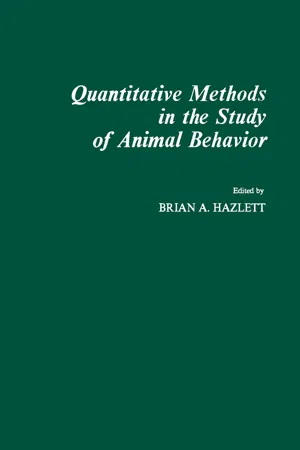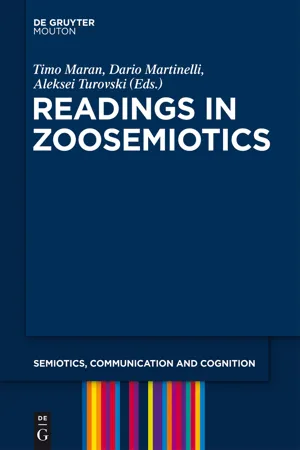Psychology
Animals and Language
"Animals and Language" explores the communication abilities of non-human animals, including their use of vocalizations, gestures, and other forms of expression. Researchers investigate the extent to which animals can comprehend and produce language, as well as the underlying cognitive processes involved. This field of study sheds light on the similarities and differences between human and animal communication systems.
Written by Perlego with AI-assistance
Related key terms
1 of 5
10 Key excerpts on "Animals and Language"
- eBook - PDF
- Susan H. Houston(Author)
- 2019(Publication Date)
- De Gruyter Mouton(Publisher)
LANGUAGE AND COMMUNICATION: ANIMAL LANGUAGE 2 6 7 very fond of animals, and to have worked extensively with them, often seem determined to find the traces of linguistic behavior from the outset. This is presumably the explanation of, for example, those reports which claim to present six words in the vocabulary of the horse. But descriptions of complex communi-cative behavior among animals are so frequent and occasionally so compellingly linguistic in character that they cannot be dis-missed without at least attempted explanation. Following are a selection of possible questions which one might pose in connec-tion with animal communication: (1) Do any animals have a language in the same sense as humans; if so, which? (2) What is the best procedure for deciding whether a given communication system is in fact a language, or, alternatively, an approximation to language? (3) If no animals can be considered to have a language, then what is the nature of their communications, if any, and how can these be compared with human communication? (4) If no animals have a language, is there a possibility that some extant species may be in the process of developing a lan-guage? 19.2. Since dogs are the most common house pets, they are the animals about which it is most often asserted that understanding of human language exists. Many dog owners believe that dogs are capable of obeying commands which they have never heard before, and thus, by extension, of understanding human language in general. It is also sometimes claimed that dogs and other pets express a variety of human emotions through their particular communication, and presumably that they do so deliberately in order to communicate with their owners. Packard states, for example, that dog-owners known that their dog utters a wide range of meaningful sounds. A dog in its bark can express sur-prise, pleasure, pleading, alarm, playfulness (1950, p. 158). - Brian Hazlett(Author)
- 2012(Publication Date)
- Academic Press(Publisher)
Further-more, the specific words used are defined by the ways in which they are used rather than by fixed relations to specific ob-jects which they represent. These ideas can be extended to encompass behavior if we consider the acts of animals the operational equivalent of words. More specifically, if we suppose that behavioral acts admit to classification and groupings when considered from the animal's point of view, then activities constitute linguistic behavior in Wittgenstein's sense. Furthermore, the ultimate meaning of the animal's behavior can be found only by consid-ering its ecological and evolutionary effect in conjunction with more immediate consequences. Since the animal's behavior is conditioned by and responsive to events occurring in its environment, behavior is simply the animal's side of an on-going operational dialogue between the animal and its environ-ment. In this sense social communication is only one of the language-games in which an animal engages. It is to be understood that the term behavior in this ENVIRONMENTAL LANGUAGES 147 context includes not only overt ethological acts but physiolo-gical and developmental events as well. All too often practi-cal restrictions on empirical methods have led to the study of development, physiology and ethology separately and without adequate reference to each other. Nevertheless it is necess-ary to retain the distinctions in part if we are to have any hope of deriving an empirical methodology from the theory pre-sented here. In doing so, however, it must be remembered that the distinctions are provisional and for methodological con-venience only. B. Scope of This Paper I shall argue below that a linguistic approach not only leads to viable experimental methods but permits inclusion of many considerations not encompassed by traditional methods, such as effects of the spatial structure of an animal's en-vironment or the import of variable durations of and time in-tervals between events.- eBook - PDF
The Psychology of Learning
An Introduction for Students of Education
- Gordon R. Cross, Edmund King(Authors)
- 2016(Publication Date)
- Pergamon(Publisher)
CHAPTER 6 Language Communication in Man and Animals A conventional distinction is nowadays made between the acquisition of language and learning a language. Acquiring is used in the sense of attaining competence in the native or mother tongue and learning is normally applied to the study of a second or foreign language. Most of this chapter will be devoted to the psychology of language acquisition. For the greater part of this century psychologists have affirmed that the fundamental distinction between man and the remainder of the animal kingdom lies in the use of language, therefore it is surprising that deep and analytical studies of its acquisition are only of comparatively recent origin. Prior to the work of Chomsky (1957) which elevated the subject to a new level, research in this field tended to be descriptive, observational and too heavily reliant on ill-adapted general learning theory, for example, con-ditioning as a possible causal explanation. Although it is true that some animals communicate with each other in a primitive vocal fashion, as for instance in giving warning calls when danger is imminent, it would be unreal to claim that this represents a genuine use of language. Similarly a parrot uttering a sequence of sounds like pretty Polly which is recognizable by most English speakers cannot be said to be talking in the sense that the bird is engaged in a simple con-versation. There is no evidence to prove that an animal is capable of generating language and this tends to rule out any theory that human language has evolved from primitive sound patterns or elementary signal systems. Discontinuity in evolution is a theory strongly supported by Lenneberg (1967) and other distinguished ethologists who propose a theory of species-specific behaviour. Tinbergen (1951) uses the term sign stimulus to describe the release of a specific and stereotyped behaviour 106 - eBook - PDF
Introducing Linguistics
Theoretical and Applied Approaches
- Joyce Bruhn de Garavito, John W. Schwieter(Authors)
- 2021(Publication Date)
- Cambridge University Press(Publisher)
Then, scientists discovered that several animals could make tools as well. More recently, scientists have been finding that animals are individuals who are self-aware and even have friends. And now, we are finding that the last bastion giving our species superiority is falling at last. We are learning that animals have language, too. 574 Animal Communication and Language 16.1 What Is the Difference between Language and Communication? In the past, biologists studying communication in animals assumed that animals were incapable of language. The prevailing thought has been that humans are the only spe- cies with the self-awareness and cognitive ability to develop an open-ended linguistic system. However, increasing evidence shows that many species are indeed capable of language, but we just haven’t yet figured out how to decode animal languages. Let’s first look at the difference between communication and language. The term animal communication, as used in the sci- entific literature, makes the assumption that through natural selection, animals are hardwired to make specific responses to certain signals just as we are hard- wired to kick when a certain spot in our knee is tapped. In this view, there is no flexibility on an animal’s part and also no intention to send any information. It just happens purely through instinct. Animals cross the line into language when they inten- tionally send particular signals to other animals, when they create new signals for changing circumstances, and when the signals that they use have a certain struc- ture that is analogous to our concept of grammar. 16.2 Information Conveyed in Animal Communication In animal communication, signals can be passed from one animal to another along several principal sensory channels: • Visual channel: Signals involving movement of body parts, body posture, and coloration. • Auditory channel: Signals involving the sending and reception of vibratory information, usually in the form of sound. - eBook - PDF
- (Author)
- 2018(Publication Date)
- De Gruyter Mouton(Publisher)
I hope that what I have to say will also throw some light on my special interests, namely the language of science and the language of poetry. It is right to ask at the outset whether there are indeed two and just two distinct categories: human language, and every kind of animal communication. Here the evidence is very reasonable. Roman Jakobson has shown in a series of studies (collected in 1962) that the several thousand human languages all have a common character, which can be traced in the way that their structure is built up layer by layer from simpler units. By contrast, the means of communication which animals use lack this layered structure, and consist rather of a vocabulary of discrete signals. This distinction is only general, and will no doubt turn out to have borderline exceptions — for example, human beings certainly make some of the same gestures and exclamations HUMAN AND ANIMAL LANGUAGES 375 to one another that animals do. It is not implied, therefore, that there is any break in evolution between human speech and its origins in animal behavior. Yet when these cautionary remarks have been made, there remains a plain division between human language as a structural system, and the code-book of signals that animals exchange; and we are justified in treating them as two distinguishable categories. The distinction made here can be put in other terms, for it is one expression of a more general contrast between human and animal behavior. In almost every setting, the responses of animals are more rigid and stereotyped than those of human beings. So the animal's responses are both fixed in and served by the utterance of stereotyped signals, which are read as rigidly by the receiver as by the sender. Indeed, we know from the work of modern ethologists that many animals single out only one feature in a situation, which then works as a direct signal — and may become a superstimulus — to release their response. - eBook - PDF
- Timo Maran, Dario Martinelli, Aleksei Turovski, Timo Maran, Dario Martinelli, Aleksei Turovski(Authors)
- 2011(Publication Date)
- De Gruyter Mouton(Publisher)
The sociobiologists’ approach consisted in first of all denying the reality of a specifically cultural dimension in human so-cieties in order to assimilate them to mechanisms that had been observed in animal societies. However, evoking the reasons for a behaviour rather than its causes is tantamount to taking a semiotic stand. In the following pages I will attempt to show that animal communications are much more complex than is usually believed, that the semiotic dimension of animal cultures has been totally neglected by ethologists, whereas it estab-lishes their relevance even more solidly, and that in return the question of animal cultures is capable of transforming biosemiotics by focusing on the social di-mension of a great many semiotic phenomena occurring in nature, by showing the necessity of taking interspecific communications into account so as to de-velop a genuine phylogenesis of meaning, and by looking more closely at the ontological status of the organisms involved in these processes. Language and Animal Communications Unlike the work on animal cultures, the recent studies on the evolution of in-telligence and the emergence of human skills consider language to be of funda-mental importance. Donald (1991) defends the thesis that not only do humans have a bigger brain, they have new systems for representing reality, in par-ticular through language. This cognitive innovation allowed humans to move from a mimetic culture to a mythic culture through the new narrative capacities offered by language. Mithen (1996) advances a scenario in which the human mind developed in three stages. - eBook - PDF
Doctor Dolittle's Delusion
Animals and the Uniqueness of Human Language
- Stephen R. Anderson(Author)
- 2008(Publication Date)
- Yale University Press(Publisher)
Exploring the abili-ties they display in these studies (but not, apparently, in nature) is certainly relevant; but that is a separate issue from whether or not they have the ca-pacity to learn and use a language in the specific sense that refers to human languages. By using the expression ‘‘human language’’ repeatedly, I do not of course mean to exclude a priori anything a nonhuman might do. The prop-erties of language that I discuss in the chapters to come are abstract enough to be dissociable from the activities of human vocal tracts and ears, hands, and eyes. They would be directly identifiable in the behavior of other ani-mals if they were indeed found there. Nothing about language in the sense intended here is intrinsically limited to systems with our specific physical organization—though as a matter of empirical fact, the capacity for lan-guage does seem to be limited to organisms with our specific neurological and cognitive organization. Research that has been conducted with an African grey parrot named Alex supplies a cautionary note concerning our lack of success in teaching human language to animals. Alex does some remarkable things, more im-pressive in many ways than the linguistic accomplishments of the widely touted chimpanzees. That should give us pause in interpreting the research done with primates, because common sense would seem to tell us that chim-panzees are smarter than parrots. Still, even Irene Pepperberg’s fascinating work falls short of what it would take to demonstrate a capacity for some-thing with the essential properties of human language in another animal species. W 12 X A n i m a l s , L a n g u a g e , a n d L i n g u i s t i c s On the basis of the available evidence, language as it appears in humans seems inescapably to be a uniquely human faculty with its own unique char-acteristics, part of the biological nature of our species. - eBook - PDF
- Brian Davies, Paul Kucharski(Authors)
- 2016(Publication Date)
- T&T Clark(Publisher)
Communication is actively sharing a common life. Discussion of communication amongst animals is too often confined to the means by which bits of information are conveyed from one to another, but this is simply a piece of anthropomorphism. Amongst men there is an important distinction between the exchange of messages and the other ways of commu-nicating. We distinguish between conversation and choral singing, though both are forms of communication; still more do we distinguish between conversation and common work, though again we have here two kinds of communication. In the pre-linguistic world of the other animals these distinc-tions have no real place: the bee that dances ‘to show the others where the honey is’ is no more (and no less) communicating with its fellow bees than when it shares their life in other ways. To single out the dance of the bees or the call of a bird from the rest of its vital activity is to project onto the pre-linguistic world a distinction that only properly has place amongst men. All shared vital activity is, then, some form of communication. We may speak of the vital response of an animal to its environment as a kind of communication. The animal vitalizes its world and endows it with significance. The world becomes the clothing of the animal and, in a way, an extension of its body. We can see this dramatically in the case of those animals that have a certain personal territory. Here the boundaries of the territory are almost like another skin; the violence with which the animal reacts to penetration of its territory is comparable to the convulsion that occurs when a weapon enters the skin. The space around such an animal has begun to share in its bodily life. ETHICS AS LANGUAGE 203 I have spent time on communication and animal life in order to lay a foundation for the use of the word when we come to the linguistic animals. In man communication reaches a new intensity, it becomes language. - eBook - PDF
- Peter Sharpe(Author)
- 2008(Publication Date)
- Continuum(Publisher)
Next, the ques-tion of whether language has a specific location in the brain will be considered and, latterly, how we need to be wary of our descrip-tions of complicated and little understood phenomena. Is Language Exclusive to Humans? 25 Where the Links Still Lie Animal communication studies are in their infancy. So before we can begin, we have to be aware of just how much we don’t know and, possibly, may never know. According to Peter Marler of the Center for Animal Behavior of the University of California, we know nothing about the electrical communication of fish, chemi-cal signals of insects, the substrate vibrations of frogs and insects, the ultrasonic signals of bats and rodents, or the infrasound of elephants (Jablonski & Aiello 1998: 1). The commonest medium used by animals to know something is smell, but precisely what an animal can tell from smells is largely unknown. Against this back-ground, it is hardly surprising that ethologists (those who study animal behaviour) confine their investigations to what can be observed. In the case of researchers interested in signalling systems, this usually means matching certain behaviour to specific sounds. At our present level of knowledge regarding this narrow spec-trum of animal behaviour three kinds of vocal signals have been observed. The first are affective , or emotional, signals. These belong to all mammals, humans included. They are not considered symbolic because they do not stand for anything other than the emotion being portrayed. This kind of communication is called iconic (because the sound is thought to resemble the emotion) and described as reflexive (lacking intention or voluntary control). A howl of pain is an expression of pain. There appears to be no cognitive content to such messages, they are purely emotional. The second kind of signal is more specific than the first and is considered symbolic. Certain animals use different calls to alert others to different situations. - eBook - PDF
- Thomas A. Sebeok, Jean Umiker-Sebeok, Thomas A. Sebeok, Jean Umiker-Sebeok(Authors)
- 2020(Publication Date)
- De Gruyter Mouton(Publisher)
Ideas are physical entities located in the form of memory traces in the brains of the group, and collectively, as an organized system, they represent 'social reality', which has become the most important part of man's environment. Communication The definition of communication has been left open so far. Ethologists use a very careful definition for animals: 'Biological communication is the action on the part of one organism (or cell) that alters the probability pattern of behavior in another organism (or cell) in a fashion adaptive to either one or both of the participants' (Wilson 1975). The term 'adaptive' in this description means that the signaling, or the response, or both have been genetically programmed to some extent by natural selection. In the case of humans, we generally understand communication as an exchange of information between two individuals. Why could we not use the definition of communication for humans with animals? The answer to this question is closely connected to the way the term 'information' is used in the definition for humans and with the modeling nature of the brain. The problem of the usage of the information concept arises from its double epistemological nature. Information, in the common sense as 'knowledge' or description, is perfectly clear and understood; the dilemma arises if it is treated as a purely biological phenomenon acting within the biological systems. These two aspects of the information concept were brilliantly distinguished by Kampis (1987a, 1987b, 1991) as effect and knowledge. Knowledge is a description that has meaning only for the observer, while the effect—the final source of The brain's models and communication 35 knowledge, according to Kampis—is the specific way a given component functions in a given system. Based on effect and knowledge, Kampis defines two kinds of information.
Index pages curate the most relevant extracts from our library of academic textbooks. They’ve been created using an in-house natural language model (NLM), each adding context and meaning to key research topics.









